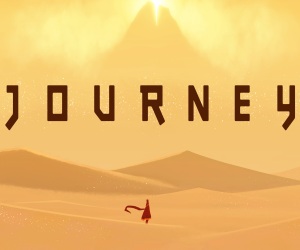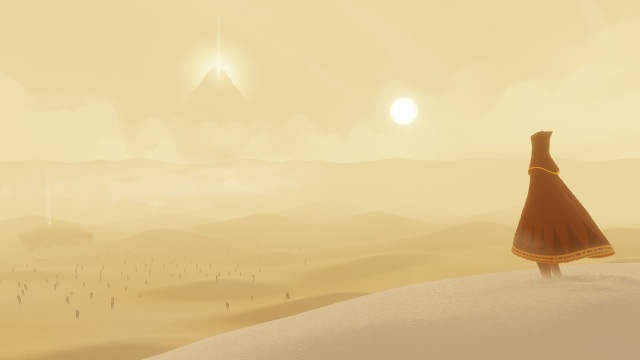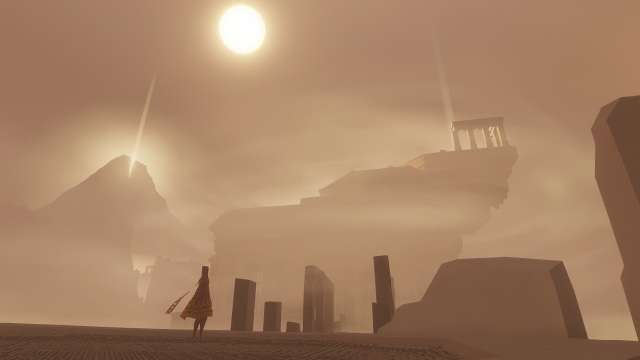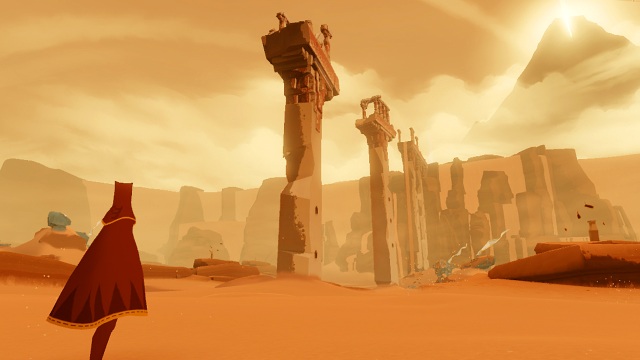Journey Review
 Game: Journey
Game: Journey
Developer: thatgamecompany
Publisher: Sony Computer Entertainment
Available on: PlayStation 3 only
The word “experience” is thrown around a lot with regard to video games. Sometimes people like to refer to narrative driven games that tug on your emotions as, “experiences”. That is true to some extent, but not in every case. When it comes to thatgamecompany, “experience” is very apt. They create wonderful, mesmerising worlds that are arguably more like an experience than a game. Flow and Flower are examples of that arty, hypnotic style that, thatgamecompany have made their name on.
When Journey was announced, many gamers were excited at what we would see from the studio. Many love what the developer has brought to the table, whilst some have consistently argued that their previous efforts, although beautiful, do not contain enough gameplay. The detractors will state that the likes of Flower, are too much art and not enough game. So, where does Journey fall? Have thatgamecompany created a beautiful and awe-inspiring world, with trite gameplay?
No…they’ve created a masterpiece.

Once the game begins, you assume the role of a robed character that has just woken up in a desert and sees a mountain in the distance. Upon traversing the first sand incline, the game’s title appears over an illuminated sun and your “Journey” well and truly begins.
There is no particular context to your actions in Journey. The game doesn’t hold your hand or direct you to any particular goal, other than the colossal mountain that is nearly always in view. That mount is your only guideline while playing Journey. But, whilst playing, it’s also understood that Journey – for all the grandeur and artistic visuals – has gameplay that is steeped in tradition and simplicity. The main character has very few functions. They can walk, jump, sing/shout, and when the opportunity presents itself, fly. Walking and jumping obviously explain themselves, but singing/shouting and flying go hand-in-hand in Journey.
As I said, you are a robed protagonist. A robed protagonist that also dons a scarf. This scarf is your key to soaring through the air and across the world in Journey. Basically, the shout function acts as a call to pieces of cloth that inhabit the game. Once you shout in their direction, they whisk you up in the air and replenish your scarf like a health bar. When the player holds down the X button, Journey’s protagonist flies through the air, however, the longer you aviate, the less your scarf is illuminated with a glow. This glow represents how long you can use the flying ability. There are shining glyphs scattered throughout the levels that lengthen the scarf and at the end of every level, your scarf will become longer still. It’s simplicity in controls adds to the overall experience and makes it a game that is easily accessible to anybody. Sixaxis controls were very important in Flower, but in thatgamecompany’s latest offering, their use is really minute. The player can move the camera around by tilting the PS3 controller in any direction, whilst also offering the option of using the right analogue stick. It’s not an essential feature and something that I found myself using very rarely.

This is without question, one of the must beautiful games you will play on a modern day console, full stop. The gorgeous desert landscape is a sight to behold as the player navigates across the sand. The sun drenches the grains upon which you wander and makes every single speck glisten. The desert environments aren’t the only ones you come across in Journey, but those alone differ in their own unique way. How the sun hits it, is a big determining factor on what pigment will show at your feet. The game ventures into other areas that are just as beautiful too. There are sections of the game that resemble an ocean bed that sway as if water is flowing amongst cloth that mimic seaweed. One of the most beautiful and contrasting parts of the game, is the part where you are travelling towards the mountain, and the ground is covered in an exquisite white snow that causes the player to struggle against a strong gale.
The mute hero has so much wonderful life and charm about them, not a word is spoken, yet their appeal is in their delicate movement and gracious negotiation of the different lands. The character’s struggle against a gust of wind or valiant attempt at ascending a hill is so endearing that the main character in Journey demands your care and affection. Additionally, the hero’s sing/shout ability will react to the situation that they are in at that time. Many emotions are felt in Journey and the central character finds themselves in many situations, sometimes their sing/shout is excitable and vibrant, whilst sometimes it is far more dainty. The way the character interacts with small pieces of cloth or more extravagant semblances of creatures from material is delightful, stunning and jaw-dropping.
The score of the game fits perfectly. The orchestral sound that accompanies the journey brings tension, elation and inspiring moments in the game to the forefront even more. The music has the ability to influence the player’s movement in a subtle way that is almost unexplainable. A simple tune that is played out on the strings had me halting in my tracks to just observe the incredible vista and scenery. The understated sound of a pan flute can be almost overwhelming, whilst the power of the orchestra’s punch is something to behold and savour. The music in Journey rivals that in any medium I’ve come across before. TGC know when it needs to be downplayed and when it is required to blast out with furious authority.

It’s a game that everyone can experience on their own, or with another nomad. The online play is a stroke of genius. On your travels, you may come across another player that is on the same journey as you, however there is no communication other than the robed figures’ skill of singing/shouting. No microphones, no PSN IDs displayed on screen, it’s complete anonymity. Almost like meeting an actual stranger. So much so, that there is no requirement to help out a travelling stranger or to interact in any way. It’s completely up to the player’s discretion. On one of my own travels, I came upon another player that was on the same journey as myself and it does create amazing, poignant moments. We both waited for one another at stages, or helped each other in ways that we could. As I said, none of this is mandatory, everyone’s experiences with other players will be completely different. However, it adds another element to the story, and what a story it is.
Obviously, for me to go any more in depth than I have about Journey’s narrative would be giving away things about a game that is basically, an interactive fable. All you need to know is that, Journey takes you on a ride that is thought provoking and glorious in every way possible. It tugs at the heart strings and reveals itself for what it truly is…a work of art.
VERDICT: Is Journey for everybody? Maybe not. However, critics of the studio’s previous efforts will find it more appealing as it’s one of their more “gamey” works. Journey, at its core is something that everyone should play. It is an experience like no other, and it is worthy of the word “experience”. The wonderful lighting, the fantastic sound cues, simple gameplay and the unrelenting beauty only add to the fairytale. All of these things are the reasons why Journey is one of the best games you’ll play all year, if not your entire life.





